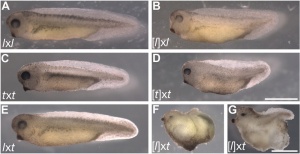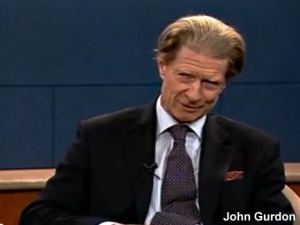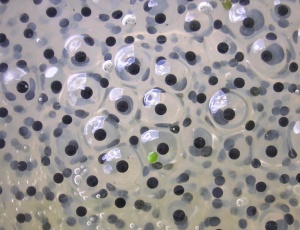Embryology History - John Gurdon: Difference between revisions
No edit summary |
|||
| Line 36: | Line 36: | ||
==Key Papers== | ==Key Papers== | ||
[[File:Detached-cell method of transplanting nuclei.jpg|thumb|300px|Detached-cell method of transplanting nuclei]] | |||
==Historic Embryologists== | ==Historic Embryologists== | ||
Revision as of 12:24, 11 October 2012
Introduction
John Gurdon in 1962 used nuclear transplantation and cloning to show that the nucleus of a differentiated somatic cell retains the totipotency necessary to form a whole organism.
(Born 1933)
2003 Current Biology Interview PMID 14521852 2009 Interview - "The birth of cloning" PMID 19132124
- Links: Frog Development | Stem Cells | Shinya Yamanaka
Some Recent Findings

|
The Nobel Prize in Physiology or Medicine 2012 was awarded jointly to Sir John B. Gurdon and Shinya Yamanaka
|
Recent References | References
Research History
- 2012 - The Nobel Prize in Physiology or Medicine 2012 awarded jointly with Sir John B. Gurdon "for the discovery that mature cells can be reprogrammed to become pluripotent".
Key Papers
Historic Embryologists
| Embryologists: William Hunter | Wilhelm Roux | Caspar Wolff | Wilhelm His | Oscar Hertwig | Julius Kollmann | Hans Spemann | Francis Balfour | Charles Minot | Ambrosius Hubrecht | Charles Bardeen | Franz Keibel | Franklin Mall | Florence Sabin | George Streeter | George Corner | James Hill | Jan Florian | Thomas Bryce | Thomas Morgan | Ernest Frazer | Francisco Orts-Llorca | José Doménech Mateu | Frederic Lewis | Arthur Meyer | Robert Meyer | Erich Blechschmidt | Klaus Hinrichsen | Hideo Nishimura | Arthur Hertig | John Rock | Viktor Hamburger | Mary Lyon | Nicole Le Douarin | Robert Winston | Fabiola Müller | Ronan O'Rahilly | Robert Edwards | John Gurdon | Shinya Yamanaka | Embryology History | Category:People | ||
|
References
- ↑ 1.0 1.1 <pubmed>22131902</pubmed>| PLoS Biol. Cite error: Invalid
<ref>tag; name 'PMID22131902' defined multiple times with different content - ↑ <pubmed>21536734</pubmed>
Reviews
<pubmed>16134025</pubmed> <pubmed>15824436</pubmed> <pubmed></pubmed>
Articles
<pubmed></pubmed> <pubmed>10761853</pubmed> <pubmed>3308408</pubmed> <pubmed>5530658</pubmed>| PDF <pubmed>5531072</pubmed> <pubmed>5967799</pubmed> <pubmed>13903027</pubmed> <pubmed>13726553</pubmed>
Search PubMed
Search PubMed Now: Gurdon+J
Terms
External Links
External Links Notice - The dynamic nature of the internet may mean that some of these listed links may no longer function. If the link no longer works search the web with the link text or name. Links to any external commercial sites are provided for information purposes only and should never be considered an endorsement. UNSW Embryology is provided as an educational resource with no clinical information or commercial affiliation.
- Wellcome Trust/Cancer Research UK Gurdon Institute is part of Cambridge University with funding from the listed two main sponsors, and other sources, supports research into the complementary areas of Cancer and Developmental Biology.
- John Gurdon - Research Lab
- Berkeley interview March 16, 2006 | YouTube
Glossary Links
- Glossary: A | B | C | D | E | F | G | H | I | J | K | L | M | N | O | P | Q | R | S | T | U | V | W | X | Y | Z | Numbers | Symbols | Term Link
Cite this page: Hill, M.A. (2024, April 23) Embryology Embryology History - John Gurdon. Retrieved from https://embryology.med.unsw.edu.au/embryology/index.php/Embryology_History_-_John_Gurdon
- © Dr Mark Hill 2024, UNSW Embryology ISBN: 978 0 7334 2609 4 - UNSW CRICOS Provider Code No. 00098G


